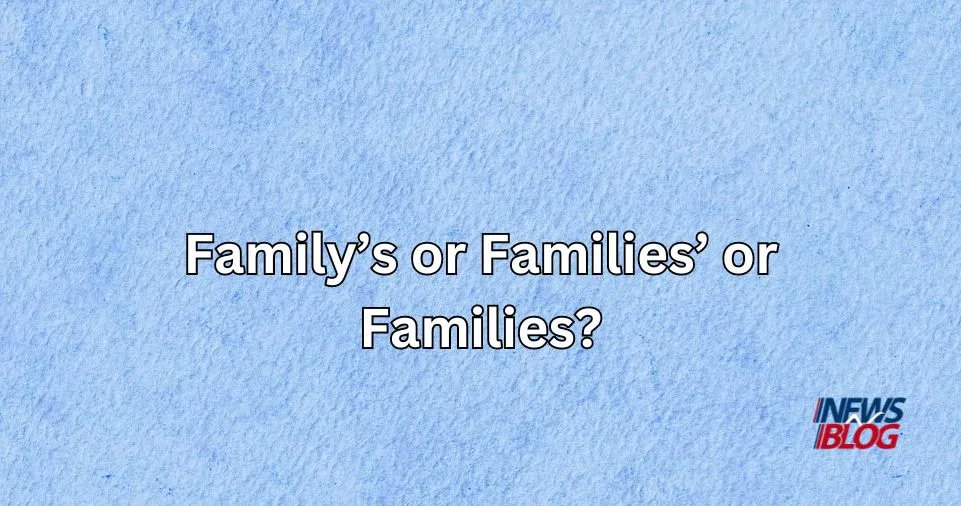In the realm of English grammar, possessives play a crucial role in indicating ownership or association.
However, when it comes to indicating possession with the word “family,” confusion often arises regarding the appropriate usage of “family’s,” “families’,” and “families.”
This article will delve into the nuances of each form, providing scenario examples to elucidate their distinct applications.
Types of Possessive
| Singular Possessive | Plural Possessive | Plural Noun |
| Family’s | Families’ | Families |
| Example: The family’s house was adorned with festive decorations. | Example: The playground was funded by the families’ contributions. | Example: Many families attended the community event. |
Family’s
When we use “family’s,” we are indicating possession by a singular family unit. This form is employed when referring to something belonging to a specific family.
The apostrophe-s (‘s) is added to the word “family” to denote ownership.
Example 1:
“The family’s car was parked in the driveway.”
In this example, “family’s” indicates that the car belongs to a particular family. The possessive form clarifies ownership, distinguishing it from other cars.
Example 2:
“The family’s decision to move was met with mixed emotions.”
Here, “family’s” denotes ownership of the decision to relocate. It signifies that the decision-making process belonged exclusively to the specified family.
Families’
Conversely, “families’” is the plural possessive form of “family.” It is used to indicate possession by more than one family.
When multiple families collectively own or possess something, the apostrophe is placed after the plural noun.
Example 1:
“The playground was built for the enjoyment of the neighboring families’ children.”
In this instance, “families’” highlights that the playground is intended for the children of multiple families. The possessive form emphasizes shared ownership among several family units.
Example 2:
“During the holiday season, the families’ traditions merged, creating a vibrant tapestry of celebrations.”
Here, “families’” denotes that the traditions being discussed belong to multiple families. It underscores the collective nature of the traditions, intertwining customs and practices from various households.
Families
While “families” without an apostrophe may seem similar to the plural possessive form, it serves a distinct grammatical function.
In this case, “families” functions as a plural noun, referring to multiple family units without indicating possession.
Example 1:
“The community center provides support services for low-income families in the area.”
In this example, “families” simply refers to more than one family residing in the community. There is no indication of possession; rather, it denotes a collective group.
Example 2:
“Several families attended the town hall meeting to voice their concerns.”
Here, “families” refers to multiple households participating in the town hall meeting. It highlights the presence of several family units without attributing ownership or possession.
Standard Plural and Possessive Plural of “Family”
Standard Plural: Families
“Several families gathered for the community event.”
Here, “families” is the standard plural form indicating more than one family without implying possession.
Singular Possessive: Family’s
“The family’s vacation photos were displayed on the wall.”
In this case, “family’s” denotes possession by a singular family. The photos belong to or are associated with a specific family.
Plural Possessive: Families’
“The families’ contributions made the charity event a success.”
“Families’” indicates possession by multiple families. The contributions are collectively owned by or associated with more than one family.
Navigating Physical and Non-Physical Possession
The possessive forms “family’s,” “families’,” and “families” not only convey ownership but also encapsulate the intricate web of physical and non-physical possession within familial relationships.
Physical Possession
- Shared Home Space: “The family’s home, with its unique blend of each member’s belongings, represents a shared physical possession where the tangible elements create a harmonious living environment.”
- Inherited Assets: “In the case of families’ inherited estate, the physical possessions like property, valuables, and the family home become tangible representations of shared ownership.”
- Material Heirlooms: “Passing down a cherished family heirloom signifies a tangible form of physical possession, connecting generations through a shared history and material object.”
Non-Physical Possession
- Emotional Bonds: “The warmth and love shared among family members transcend the physical, representing a non-physical possession that strengthens the emotional fabric of the family.”
- Shared Memories: “The collection of shared memories and experiences becomes a non-physical possession, shaping the family’s narrative and fostering a sense of shared identity.”
- Values and Beliefs: “Passing down family values and beliefs signifies a non-physical possession, influencing the mindset and guiding principles of the entire family.”
When to Use Which Form
In certain contexts, it can be challenging to determine whether the possessive form should be singular or plural. Let’s examine a scenario where ambiguity arises:
“The family’s/families’ commitment to education is commendable.”
In this case, both forms can be grammatically correct, but the intended meaning may differ.
If the emphasis is on a singular family’s commitment, “family’s” is appropriate. If the focus is on the combined commitment of multiple families, “families’” is the preferred choice.
Conclusion
In summary, the distinctions between “family’s,” “families’,” and “families” are crucial in conveying precise meaning within sentences.
“Family’s” signifies possession by a singular family unit, “families’” denotes possession by multiple family units, and “families” without an apostrophe functions as a plural noun referring to multiple families without indicating possession.
Understanding these nuances enhances clarity and precision in written and spoken communication.
By mastering the appropriate usage of possessive forms, writers can effectively convey relationships and ownership within the context of family dynamics.
Also Read:

